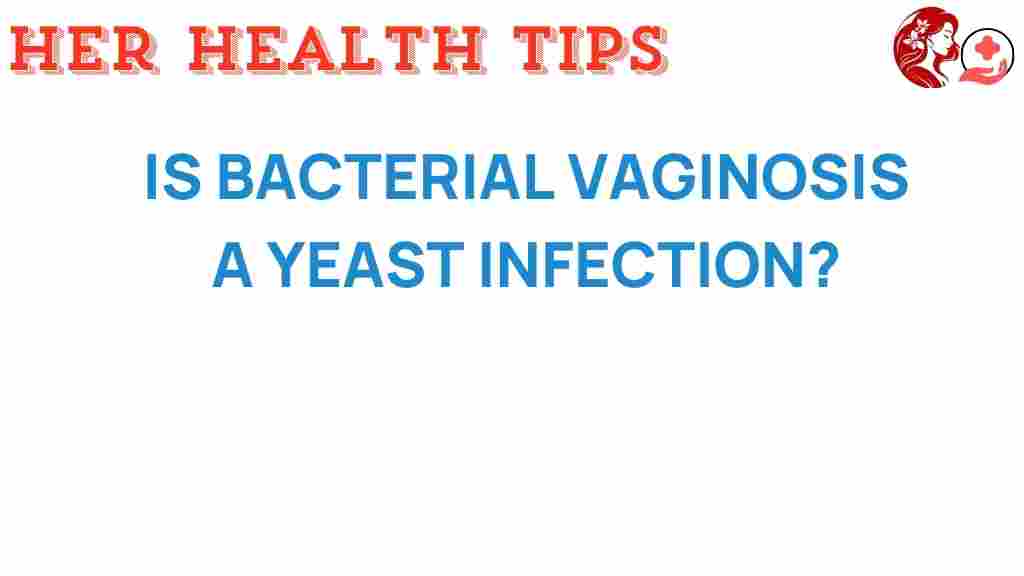Unraveling the Mystery: Is Bacterial Vaginosis a Yeast Infection?
Bacterial vaginosis (BV) and yeast infections are two common conditions that affect many women, yet they are often confused with one another. Understanding the differences between these two conditions is crucial for effective treatment and maintaining optimal women’s health. In this article, we will explore what bacterial vaginosis is, how it differs from a yeast infection, their symptoms, diagnosis, treatment options, and the role of the microbiome in these infections.
What is Bacterial Vaginosis?
Bacterial vaginosis is a condition that results from an imbalance in the normal bacteria that inhabit the vagina. The vagina is home to a diverse community of microorganisms, mainly dominated by Lactobacilli. When the balance of these bacteria is disrupted, harmful bacteria can flourish, leading to symptoms of bacterial vaginosis.
Symptoms of Bacterial Vaginosis
The symptoms of bacterial vaginosis can vary from woman to woman. Common symptoms include:
- Thin, gray, or white vaginal discharge
- Strong fishy odor, especially after sexual intercourse
- Burning sensation during urination
- Itching around the vagina
It’s important to note that some women may experience no symptoms at all. Therefore, regular check-ups and awareness of any changes in your body are vital for women’s health.
What is a Yeast Infection?
A yeast infection, also known as candidiasis, is primarily caused by an overgrowth of a fungus called Candida, most commonly Candida albicans. Unlike bacterial vaginosis, which involves a bacterial imbalance, a yeast infection is a fungal infection.
Symptoms of a Yeast Infection
The symptoms of a yeast infection can also overlap with those of bacterial vaginosis, leading to confusion. Common symptoms of a yeast infection include:
- Thick, white, cottage cheese-like vaginal discharge
- Intense itching and irritation in the vaginal area
- Redness and swelling of the vulva
- Pain during intercourse
- Burning sensation during urination
Diagnosis: How Are They Identified?
Diagnosing bacterial vaginosis and yeast infections requires a healthcare provider’s expertise. Here’s how the diagnosis typically proceeds:
Diagnosis of Bacterial Vaginosis
A healthcare provider may perform the following to diagnose bacterial vaginosis:
- Medical History: Discussing symptoms and medical history.
- Physical Examination: A pelvic exam to check for discharge and odor.
- Laboratory Tests: Microscopic examination of vaginal discharge or pH testing.
Diagnosis of Yeast Infection
The diagnosis process for a yeast infection is similar:
- Medical History: Discussing symptoms and potential risk factors.
- Physical Examination: A pelvic exam to inspect for signs of infection.
- Laboratory Tests: Culture tests or microscopic examination of the discharge.
In some cases, a healthcare provider may perform tests to rule out sexually transmitted infections (STIs) or other conditions.
Treatment Options for Bacterial Vaginosis and Yeast Infections
Understanding the treatment options for both conditions is crucial for effective recovery and maintaining women’s health.
Treatment for Bacterial Vaginosis
The typical treatment for bacterial vaginosis includes:
- Antibiotics: Prescription medications such as metronidazole or clindamycin.
- Probiotics: Some studies suggest that probiotics may help restore the natural vaginal flora.
Treatment for Yeast Infections
For treating yeast infections, the recommended options are:
- Antifungal Medications: Over-the-counter creams or prescription medications like fluconazole.
- Home Remedies: Some women find relief using home remedies, though their effectiveness can vary.
Microbiome: The Key Player in Vaginal Health
The vaginal microbiome plays a vital role in maintaining women’s health. A balanced microbiome rich in Lactobacilli helps protect against infections by producing lactic acid and other substances that inhibit the growth of harmful bacteria and fungi.
Factors that can disrupt the vaginal microbiome include:
- Antibiotic use
- Hormonal changes (e.g., during menstruation or pregnancy)
- Unprotected sex
- Increased sugar intake
Maintaining a healthy microbiome can help prevent both bacterial vaginosis and yeast infections.
Troubleshooting Tips for Managing Symptoms
If you experience symptoms of bacterial vaginosis or a yeast infection, consider the following troubleshooting tips:
- Keep the Area Clean: Maintain good hygiene, but avoid douching, which can disrupt the natural balance of bacteria.
- Wear Breathable Fabrics: Choose cotton underwear and avoid tight-fitting clothing to reduce moisture.
- Limit Sugar Intake: Reducing sugar may help prevent yeast overgrowth.
- Stay Hydrated: Drink plenty of water to support overall health.
Conclusion
In conclusion, bacterial vaginosis and yeast infections are distinct conditions that affect many women. Understanding the differences between these infections, their symptoms, diagnosis, and treatment options is essential for maintaining women’s health. If you experience any symptoms or have concerns about your vaginal health, consult a healthcare provider for guidance.
For more information on women’s health topics, including the importance of the microbiome, check out this external resource. And remember, maintaining a healthy lifestyle and being aware of your body’s changes can empower you to take charge of your health.
For further reading on symptoms and treatment options, visit our internal page dedicated to women’s health.
This article is in the category Reproductive and created by HerHealthTips Team
